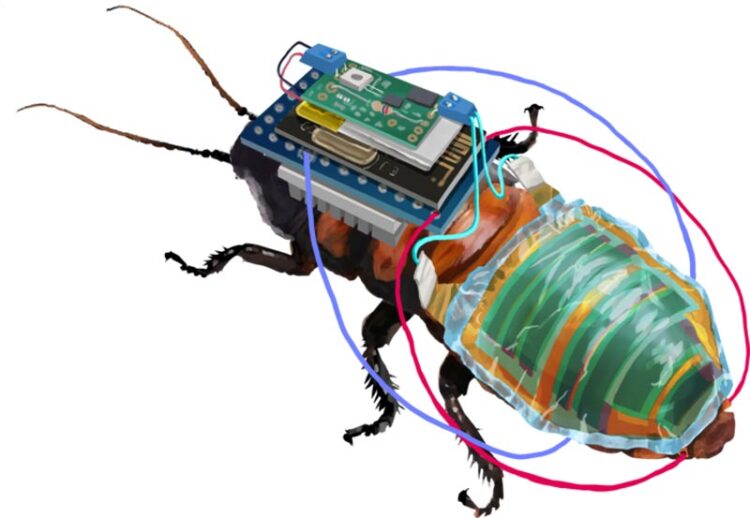Robo-bug: a rechargeable, remote-controllable cyborg cockroach

Researchers at RIKEN, Japan have created remote controlled cyborg cockroaches, equipped with a tiny wireless control module that is powered by a rechargeable battery attached to a solar cell.
Credit: RIKEN
An international team led by researchers at the RIKEN Cluster for Pioneering Research (CPR) has engineered a system for creating remote controlled cyborg cockroaches, equipped with a tiny wireless control module that is powered by a rechargeable battery attached to a solar cell. Despite the mechanic devices, ultrathin electronics and flexible materials allow the insects to move freely. These achievements, reported in the scientific journal npj Flexible Electronics on September 5, will help make the use of cyborg insects a practical reality.
Researchers have been trying to design cyborg insects—part insect, part machine—to help inspect hazardous areas or monitor the environment. However, for the use of cyborg insects to be practical, handlers must be able to control them remotely for long periods of time. This requires wireless control of their leg segments, powered by a tiny rechargeable battery. Keeping the battery adequately charged is fundamental—nobody wants a suddenly out-of-control team of cyborg cockroaches roaming around. While it’s possible to build docking stations for recharging the battery, the need to return and recharge could disrupt time-sensitive missions. Therefore, the best solution is to include an on-board solar cell that can continuously ensure that the battery stays charged.
All of this is easier said than done. To successfully integrate these devices into a cockroach that has limited surface area required the research team to develop a special backpack, ultrathin organic solar cell modules, and an adhesion system that keeps the machinery attached for long periods of time while also allowing natural movements.
Led by Kenjiro Fukuda, RIKEN CPR, the team experimented with Madagascar cockroaches, which are approximately 6 cm long. They attached the wireless leg-control module and lithium polymer battery to the top of the insect on the thorax using a specially designed backpack, which was modeled after the body of a model cockroach. The backpack was 3D printed with an elastic polymer and conformed perfectly to the curved surface of the cockroach, allowing the rigid electronic device to be stably mounted on the thorax for more than a month.
The ultrathin 0.004 mm thick organic solar cell module was mounted on the dorsal side of the abdomen. “The body-mounted ultrathin organic solar cell module achieves a power output of 17.2 mW, which is more than 50 times larger than the power output of current state-of-the art energy harvesting devices on living insects,” according to Fukuda.
The ultrathin and flexible organic solar cell, and how it was attached to the insect, proved necessary to ensure freedom of movement. After carefully examining natural cockroach movements, the researchers realized that the abdomen changes shape and portions of the exoskeleton overlap. To accommodate this, they interleaved adhesive and non-adhesive sections onto the films, which allowed them to bend but also stay attached. When thicker solar cell films were tested, or when the films were uniformly attached, the cockroaches took twice as long to run the same distance, and had difficulty righting themselves when on their backs.
Once these components were integrated into the cockroaches, along with wires that stimulate the leg segments, the new cyborgs were tested. The battery was charged with pseudo-sunlight for 30 minutes, and animals were made to turn left and right using the wireless remote control.
“Considering the deformation of the thorax and abdomen during basic locomotion, a hybrid electronic system of rigid and flexible elements in the thorax and ultrasoft devices in the abdomen appears to be an effective design for cyborg cockroaches,” says Fukuda. “Moreover, since abdominal deformation is not unique to cockroaches, our strategy can be adapted to other insects like beetles, or perhaps even flying insects like cicadas in the future.”
Journal: npj Flexible Electronics
DOI: 10.1038/s41528-022-00207-2
Method of Research: Experimental study
Subject of Research: Animals
Article Title: Integration of body-mounted ultrasoft organic solar cell on cyborg insects with intact mobility.
Article Publication Date: 5-Sep-2022
Media Contact
Masataka Sasabe
RIKEN
masataka.sasabe@riken.jp
Office: 81-48-462-1225
All latest news from the category: Power and Electrical Engineering
This topic covers issues related to energy generation, conversion, transportation and consumption and how the industry is addressing the challenge of energy efficiency in general.
innovations-report provides in-depth and informative reports and articles on subjects ranging from wind energy, fuel cell technology, solar energy, geothermal energy, petroleum, gas, nuclear engineering, alternative energy and energy efficiency to fusion, hydrogen and superconductor technologies.
Newest articles

NASA: Mystery of life’s handedness deepens
The mystery of why life uses molecules with specific orientations has deepened with a NASA-funded discovery that RNA — a key molecule thought to have potentially held the instructions for…

What are the effects of historic lithium mining on water quality?
Study reveals low levels of common contaminants but high levels of other elements in waters associated with an abandoned lithium mine. Lithium ore and mining waste from a historic lithium…

Quantum-inspired design boosts efficiency of heat-to-electricity conversion
Rice engineers take unconventional route to improving thermophotovoltaic systems. Researchers at Rice University have found a new way to improve a key element of thermophotovoltaic (TPV) systems, which convert heat…



